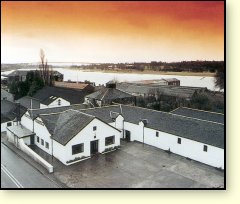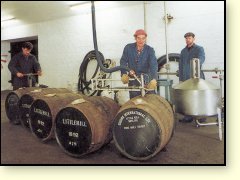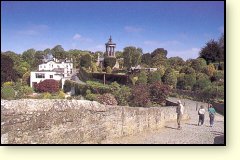
Location: Central/Southerrn Highlands
Roads: Off the A814
Hours: Closed to visitors
Phone: 01389-874154
|
Text from The Whisky Trails, Copyright © Gordon Brown 1993:
If nearby Auchentoshan distillery lies beside the line of the old Roman wall, Littlemill is close by another long-distance engineering feat that crossed Scotland – the Forth and Clyde canal. The waterway was completed in 1790, just a dozen years after Littlemill itself is thought to have begun whisky production. The canal joins up with the Clyde at the village of Bowling where, in 1802, the world’s first practical steamship, Symington’s ‘Charlotte Dundas’, had its initial trials.
Littlemill, a Lowland malt, is a most interesting distillery in a pretty setting. With its probable foundation date of 1772, it is one of the three oldest distilleries in Scotland but it was also something of a test-bed for an American inventor who improved and rethought a number of aspects of malt whisky distillation.
Like its neighbour Auchentoshan, Lowland Littlemill uses water drawn from what is technically the Highlands to produce its whisky. The distillery shares a pipeline from the Auchentorlie Burn in the Kilpatrick Hills with British Rail and some small local shipyards. In fact, Littlemill’s malt also comes from the other side of the Highland Line.
The first licensee after the facilitating 1823 Excise Act, Jane Macgregor, may well have been one of the earliest women distillers in Scotland. In 1875, just over 100 years after its inception, the distillery was rebuilt. In 1931, American Duncan Thomas bought the distillery and began putting his ideas into practice - a process that was still going on 30 years later. He modified a Saladin Box system of malting and the double ventilation towers over a single drying kiln are a one-off in Scotland.
The stills are copper but have outer skins of light aluminium as lagging and, most remarkably, they have rectifying columns instead of the swan-necks customary on pot-stills. In thus combining pot- and column-still elements, Thomas sought the capacity to ‘tune in’ at a lower or higher refining level and produce a hybrid spirit that would age faster. His technique has been embraced by Japanese distillers, who experiment with many different heads on identical pot-still bases to seek variations on given distilling themes.
The scale and pertness of the whitewashed distillery buildings are attractive, particularly in view of the nearness to the sprawl of Glasgow. Littlemill was triple-distilled until the 1930s, when it switched to the present double-distilled product. The distillery closed for some years during the 1980s before reopening under the ownership of Gibson International, the company having been formed by a management buy-out. The distillery ceased production in 1992 and Loch Lomond Distillers took over in 1994. The distillery remains closed, but supplies for bottling will be available for many years.
The Whisky
Text from The Whisky Trails, Copyright © Gordon Brown 1993:

After the distillation process, the spirit is drawn from the spirit vat into oak casks for maturation.
|
The variation in spirit types possible with Littlemill’s single pair of stills meant that, for a while, the distillery produced three different malts. Dumbuck was a heavily peated whisky – most unusual for a Lowland distillery – and Dunglass had ‘big’ and full texture with a very light peat accompaniment. They were discontinued in the early 1970s. Today Littlemill is in the Lowland mould – delicate, gentle, sweet and malty.
Source of water
Kilpatrick Springs
Of interest
Text from The Whisky Trails, Copyright © Gordon Brown 1993:
• Hill House in Helensburgh was a ‘total design’ commission for his home given to Charles Rennie Mackintosh by the Glasgow publisher Blackie. Everything is integrated and complementary, including the furniture. The windows are ingenious; they swivel as well as moving up and down. It all looks so avant garde, yet it dates from 1902. Visitors welcome. (Upper Colquhoun Street.) Helensburgh was also the birthplace of John Logie Baird, the inventor of television.

The village of Alloway was the birthplace of Robert Burns.
|

Robert Burns - portrit by Alexander Nasmyth, and can be seen in the National Portrait Gallery of Scotland.
|
• Loch Lomond Distillery is sited less attractively than its name suggests, but it produces a fine light Highland malt called Inchmurrin, named after the largest island in the Loch.
• The Burrell Collection in parkland at Pollok, near Glasgow, is one of the world’s greatest private collections of art objects, and was bequeathed to the citizens of Glasgow.
• Charles Rennie Mackintosh: Worth visiting in Glasgow are the School of Art designed inside and out by Mackintosh; the ‘Art-Lover’s House’ in Bellahouston Park (designed by Mackintosh in 1901 and built in 1989); and the Willow Tearoom, preserved within a Glasgow store.
• The Johnnie Walker Bottling Plant at Kilmarnock welcomes visitors and there are daily tours of the bottling lines.
• Croy ‘Electric’ Brae at Dunure embodies an optical quirk of the lie of the roadway, which gives the illusion of cars moving without power. A car put into neutral at a given spot will apparently move uphill under its own power although the slope is, in fact, downhill.
• Robert Burns is associated with many sites in Ayrshire; start with his birthplace at Alloway, just south of Ayr.
• Culzean Castle, designed by Robert Adam, sits on a precipice on the coast 12 miles south of Ayr. Its grounds are now a country park.